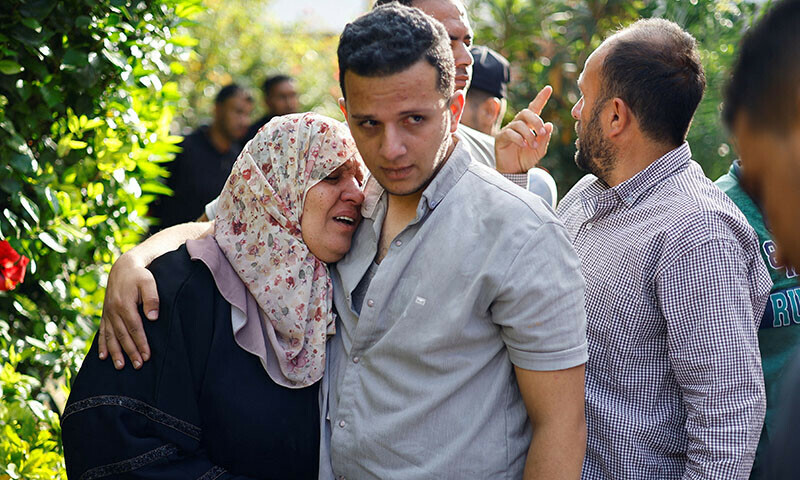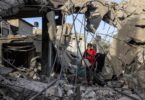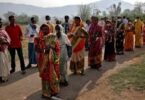GAZA (AFP): Around 3,000 people, mostly children, have been killed in Israeli strikes on the Gaza Strip since October 7, the Palestinian health ministry said on Monday as the humanitarian crisis in the enclave continues to worsen.
More than 12,500 others have been wounded since Israel started bombarding Gaza in retaliation for Hamas attacks in Israel which killed more than 1,400 people. The ministry added that 61 Palestinians were also killed while 1,250 were wounded in the occupied West Bank during the same period. Israel has vowed to annihilate the Hamas group after its fighters killed 1,300 people — the deadliest single day in Israel’s 75-year history. It now prepares to escalate a ground offensive in response to the Hamas blitz.
On Tuesday, Prime Minister Benjamin Netanyahu called for broad international support in the country’s war against Hamas. “The savagery that we witnessed perpetrated by the Hamas murderers coming out of Gaza were the worst crimes committed against Jews since the Holocaust,” Netanyahu said, referring to the extermination of more than six million Jews by the Nazis.
Israel has tightened its blockade on Gaza, including by restricting the entry of food, water and fuel and bombarding the area with air strikes that have killed thousands of Palestinians, displaced hundreds of thousands more and resulted in severe shortages of food, water and medical supplies. According to the United Nations’ World Food Programme, the food situation in the besieged Gaza Strip is running “really short”. “Inside the shops, the stocks are getting close to less than a few days, maybe four or five days of food stocks left,” WFP’s Middle East spokeswoman Abeer Etefa, told reporters in Geneva via video link from Cairo. She said that out of five flour mills in the Gaza Strip, only one was operating due to security concerns and the unavailability of fuel. “So the bread supply is running low and people are lining up for hours to get bread,” she said.
Only five bakeries out of 23 in Gaza contracted by WFP were still in operation, she added. “Our food supplies within Gaza are running really short,” said Etefa. The spokeswoman said there has been no looting of WFP warehouses, and “anyway, whatever we have left in the warehouses is so little”. “Hospitals are at a breaking point and are overflowing and with people desperately seeking a safe shelter,” the WHO has said. “Crowding is getting worse. Over 30,000 people are sheltering at Shifa Hospital alone,” the UN agency told AFP, quoting Hamas health ministry figures. “We are extremely concerned about disease outbreaks due to mass displacement and poor water and sanitation among people who are already in a dire situation.”
The hospitals are attractive because they have been relatively spared from the Israeli bombing raids that have hit Gaza every day since the October 7 attacks. But the WHO says that 111 medical buildings have been hit, 12 medical workers have been killed and 60 ambulances targeted. About one million people from northern Gaza have moved to Khan Yunis and other southern districts to avoid the looming Israeli ground offensive. About 100,000 people are left in the northern district around Gaza City that Israel says is a Hamas stronghold and has warned will be the target of its assault. Conditions across the tiny territory are worsening every day for the 2.4 million population, according to aid agencies. Unicef, the UN children’s agency, has said that unless water and fuel are sent “immediately”, Gaza inhabitants are in “imminent danger” of epidemics and death.
Aid agencies have been flying supplies into El Arish airport in Egypt — around 20 kilometres away from the Rafah border crossing and the only one into the Gaza Strip not controlled by Israel. So far Egypt has kept the crossing closed to aid going in or foreign nationals trying to flee, as Israel has repeatedly struck the Palestinian side of the crossing. Ahmed Salem of the Sinai Foundation said that the trucks heading for the border contained Egyptian aid and that the international aid remained in warehouses.
Salem and another security source said Egypt had repaired the roads within the crossing that had been damaged by Israeli strikes. Etefa said the WFP had mobilised over 300 metric tonnes of food that was either at or on its way to the Rafah border crossing from Egypt into the Gaza Strip — enough food to feed around 250,000 people for one week.
“Everyone is still very hopeful that we will be able to get inside and this is why more supplies are on the way,” she said. “We call for unimpeded access, safe passage for desperately-needed humanitarian supplies into Gaza.” The UN’s humanitarian chief Martin Griffiths is due to arrive in Cairo on Tuesday on a visit to the region, expected to last several days, to negotiate aid access to the Gaza Strip. He is set to go to Israel, and, if conditions permit, to the Palestinian territories, a spokesman said. Separately, Dr Richard Brennan, regional emergency director of the World Health Organisation Eastern Mediterranean regional office, said the agency was meeting with “decision-makers” today to open access to Gaza as soon as possible. “We have aid south of Rafa and waiting for the go ahead to get entry to Gaza,” he said, referring to the Rafa crossing, which was a vital artery before the fighting and is now a key route for desperately needed supplies into Gaza.







